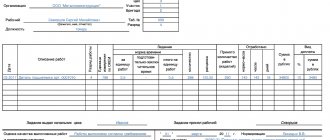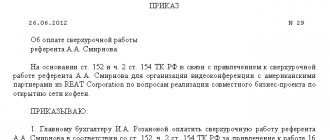What is a division of the working day?
Division of the working day is the fragmentation of a shift into a number of parts, between which there are breaks. Working hours should not exceed established standards. This form of labor is regulated by Article 105 of the Labor Code of the Russian Federation. It regulates:
- Reasons for introducing such a schedule.
- Maximum working hours.
The Labor Code sets out only the most general principles of separation. However, the code does not provide any explanations regarding the number of segments in a working day or their duration. All this is at the discretion of the employer. The schedule must be included in internal regulations. As a rule, the shift is divided into two parts. If the break between them is less than 2 hours, the working day will be standard. Rest time is reserved for eating. If the break is more than 2 hours, the shift can be considered split. If required, the number of these segments can be large. The number of breaks depends on the characteristics of the specific job.
IMPORTANT! A split day is not recognized as shift work. These forms of labor are regulated by various regulations.
ATTENTION! Certain nuances of a fragmented day are established by part 1 of article 100 of the Labor Code of the Russian Federation.
Normal working hours
The following working hours can be distinguished:
- daily five-day work, including two days off
- daily six-day work, including one day off
- working week with days off provided according to a variable schedule
- summarized work time tracking
This schedule is called a single-shift work schedule.
In cases of daily recording of work time, any work beyond the norm is overtime.
The summarized time recording used in this mode (the point is that the time worked in one day on average is equal to the standard working day for the corresponding accounting period) serves to measure working time. How long should it be taken into account? Set by the employer, but not more than a year in advance. It turns out that the amount of time worked by such an employee cannot exceed the number of working hours determined by the norm.
When does it make sense to split your workday?
As already mentioned, the intensity of work may vary throughout the day. For example, in the afternoon there is practically no work, but in the morning and evening there are a lot of orders. In this case, splitting the day is necessary to ensure that employees are at the duty station only when there is work. Otherwise, people will simply sit in the office and do nothing. That is, the main goal of separation is the rational distribution of time. As a rule, the work schedule in question is practiced in public utilities, transport companies, and civil aviation. The conditions for fragmentation are listed in Article 105 of the Labor Code of the Russian Federation:
- Special specificity of activity.
- Work at varying intensity levels that vary throughout the shift.
- The enterprise has a corresponding internal act agreed upon with the trade union.
- Inability to work throughout the working day. For example, it is impossible to clean an office space in the presence of employees. In this case, the cleaner switches in the middle of the shift. During this time, employees are entitled to a break.
IMPORTANT! The employer does not have the right to split shifts at will. Objective reasons are needed for separation. If labor disputes arise, you will have to prove the existence of these grounds. The employer is recommended to thoroughly study Article 105 of the Labor Code of the Russian Federation.
Shift working hours
Shift work - working in shifts throughout the day. In this case, workers work different shifts for a certain period of time, for example, three days.
Such work is used for the purposes of production efficiency and business activity. For example, in order to increase the volume of services provided or products produced. When the production process exceeds the permissible operating time.
Under this regime, each group of workers works according to a shift schedule.
Workers are provided with continuous rest - 42 hours per week and between-shift rest - double the duration of the shift.
There are day, evening and night shifts. If 50% of the shift duration falls on the time period from 22.00 to 06.00, then such a shift is considered a night shift.
Features of breaks
Breaks between sections of the working day will not be paid. Their number depends on the discretion of the employer. There are professions for which breaks are regulated by industry regulations:
- Participants of civil aviation vessels.
- Drivers of trams, trolleybuses and buses.
- Railway transport employees who service service cars.
- Subway employees who serve passengers.
- People working in educational institutions if students are there 24 hours a day.
- Communications staff.
- People who care for animals.
- Employees of Spetsstroy subjects.
- Employees of ground electric vehicles.
The specifics of fragmentation of the working day should not violate the rights of workers. This rule is specified in Part 2 of Article 329 of the Labor Code of the Russian Federation. If the separation is subject to industry regulations, the employer must take this into account when setting the schedule.
ATTENTION! In order to introduce day splitting, the employer must obtain the consent of the trade union and then draw up an internal act. If there is no trade union, when developing a schedule, you need to focus on the opinion of workers. If employees are against fragmentation, but the employer insists on his own, they should contact the labor inspectorate.
What will happen to lunch time?
Persons with split working hours are not deprived of the right to a lunch break. This right is regulated by Part 1 of Article 108 of the Labor Code of the Russian Federation. Lunch duration ranges from 30 minutes to 2 hours. The lunch break time may be added to the break time between parts of the shift. This rule is established by part 1 of article 108 of the Labor Code of the Russian Federation.
Shift working hours
Shift working hours are a form of labor process not at the place of residence of workers, when the possibility of their daily return to their place of residence is excluded.
A shift is a period consisting of time spent performing work and rest time between shifts.
The duration of the shift cannot exceed one month, but in exceptional cases it can be extended to three months. In this case, the shift can last 12 hours daily.
With this working time regime, summarized time tracking is established. Including travel time to the place of work, vacation time falling within this calendar period of time.
Labor legislation prohibits the involvement of minors in work of this nature. The work of women and persons with medical contraindications is separately regulated.
Additional payment for splitting the day
You need to understand that splitting the day usually causes a lot of inconvenience for employees. The worker has to leave work in the middle of the day and then return. For this reason, fragmentation must be compensated. The procedure and amount of payments are regulated by the laws of the Russian Federation and internal regulations, as stipulated in Article 149 of the Labor Code of the Russian Federation. This is precisely compensation, and therefore it is not included in the salary. The amount of payments depends on the industry and is set on the salary or tariff rate:
- Women who are employed in rural areas – 30%.
- People employed in housing and communal services, consumer services - 30%.
- Managers of Russian Railways – 30%.
The employer does not have the right to set a lower bonus. However, the amount of compensation may be increased. The amount of payments is fixed in internal regulations.
Responsibility of the employer for payment of compensation in a smaller amount
If the employer sets a smaller amount of compensation, the employee needs to file a complaint with the State Labor Inspectorate (SIT). Based on the complaint, the State Tax Inspectorate issues an order to the employer to correct the violations, which is stipulated in Article 357 of the Labor Code of the Russian Federation. An inspection is underway. If violations are discovered during the process, a fine is imposed on the employer:
- For officials – from 1 to 5 thousand rubles.
- For legal entities – from 30 to 50 thousand rubles.
These fines are established by part 1 of article 5.27 of the Code of Administrative Offenses of the Russian Federation.
How are wages paid during a shift work schedule?
Due to the nature of the work of some enterprises, they introduce a shift work schedule, in which employees work not one, but two or three shifts per day.
This regime is appropriate, for example, for enterprises in which the duration of the production process is longer than the duration of work established by labor legislation.
Also, several shifts can be introduced for more complete and efficient use of existing equipment.
In any of these cases, the question arises of how to properly organize the payment of employees and keep track of working hours. The rules and features of payment, as well as possible problems, are worth considering in more detail.
If you want to find out how to solve your particular problem, please contact us through the online consultant form or call :
- Moscow: +7(499)350-6630.
- St. Petersburg: +7(812)309-3667.
Time tracking
Moreover, this requirement applies to all employers without exception, regardless of whether they are a legal entity or an individual. The form of ownership also does not play any role.
Record keeping is carried out according to general rules using a working time sheet of the established form, in which data on all hours worked by the employee is entered. In modern conditions, there are three types of such accounting.
Daily
Can only be used if:
- the working week consists of 5 or 6 days;
- The daily duration of the work shift is the same.
For calculations under the daily schedule, each day worked by the employee for the entire working period is taken into account.
Monday
When using this type of accounting, the length of the working day should be the same every week. The duration of an employee’s shift or daily work is regulated by the schedule.
If you want to find out how to solve your particular problem, please contact us through the online consultant form or call :
- Moscow: +7(499)350-6630.
- St. Petersburg: +7(812)309-3667.
Summarized
It is used in cases where the enterprise or organization cannot implement the daily shift duration established for specific categories of employees.
For example, such a situation may arise if an employee is unable to work less than the required 8 or 40 hours per day or week, respectively.
In this case, the maximum permissible number of hours for the entire year is calculated, and the shift schedule is drawn up in accordance with the result obtained.
As a result, it may turn out that an employee works 50 hours one week, 30 hours another, and at the end of the year the established norm is met. When conducting it, the employer is obliged to set the following parameters:
Length of the accounting period. It can be a month, a quarter, or a year. At the same time, for workers with normal working conditions it cannot exceed a year, for those who work in harmful and dangerous conditions - three months.
Standard working hours for various categories of citizens. It can be determined using the production calendar , which is approved annually.
Schedule. This document must also be developed and put into effect by order of the head of the enterprise. A schedule is drawn up taking into account the established norm of working hours.
The procedure for determining wages. In this case, a salary or an hourly rate can be selected.
The employer can establish summarized accounting both in relation to all employees of the enterprise, and only for certain of them. In this case, the employee must be familiar with this information by including it in the employment contract or by studying the relevant local regulatory act against signature.
Payment for a shift schedule
Wages at a particular enterprise are calculated to an employee based on the established wage system. Depending on this, it can be calculated in two ways.
At a set hourly rate
In this case, to determine the amount to be paid, it is necessary to multiply the rate by the number of hours actually worked by the employee. Data about this is taken from the time sheet maintained at the enterprise.
Example:
In this case, the number of work shifts is 8, the actual time worked is 192 hours. Therefore the salary is equal to:
Salary = 192 * 90 = 17,280 rub.
However, this amount is not the final amount, because the employee is also entitled to additional payment for night work, as well as for overtime work. The features of such an additional payment will be discussed further.
If in this example the employee worked on a “every two days” schedule, then the number of shifts and hours worked would be 10 and 240, respectively. In this case, the salary is an order of magnitude higher:
Salary = 240 * 90 = 21,600 rub.
In addition to additional pay for night and overtime work, an employee could also qualify for additional money for working on a holiday, since one of his shifts would fall on March 8. However, with such a schedule, there is a lot of overtime in excess of the monthly norm (168 hours), which is undesirable and in some cases may be prohibited by law.
In accordance with the salary established for the employee
In such a situation, it is paid in full, but provided that the employee has worked the standard hours established for the accounting period. If this standard is not met, the salary is proportionally reduced. In case of processing, an additional payment is due.
Example:
First of all, it is necessary to determine the time standard for the month in question, established using the production calendar. It is 168 hours per week, the number of working days in a month is 21 days. The employee's hourly rate is:
Emergency = 15,000 / 168 = 89.3 rubles/hour
In fact, the employee worked 16 working days. The number of hours worked in this case will be:
H = 16 * 10 = 160 hours
Since the employee did not fully work the standard time, her salary will be:
Salary = 160 * 89.3 = 14,285 rubles.
As already noted, in the event of overtime or if part of the shift coincides with night time, the employee is entitled to additional payments to his salary, the minimum amount of which is established by law.
Features of payment at night
When working in several shifts, a situation often arises in which part of the shift or its entire duration occurs at night. In accordance with Art. 154 of the Labor Code of the Russian Federation, such work must be paid at a higher rate compared to normal working conditions.
In this case, the minimum amount of additional payment is 20% of the hourly tariff rate or salary, however, it can be increased by local regulations. To account for the number of hours worked at night, you can indicate daytime and nighttime separately on the timesheet.
Payroll calculation for night work is worth considering using a separate example:
It is necessary to determine the salary for March 2021 if the employee worked 16 shifts in a month, each lasting 9 hours. First you need to determine the amount of time actually worked:
B = 16 * 9 = 144 hours
Of them:
- 112 hours - daytime (7 * 16);
- 32 hours - night time (2 * 16).
Payment for daytime hours will be:
OD = 112 * 105 = 11,760 rubles.
In accordance with the collective agreement in force at the enterprise, the additional payment for night hours is set at 20% of the hourly tariff rate. Therefore, the payment for night time will be equal to:
OH = 32 * 105 * 1.2 = 4,032 rubles.
The final salary the employee will receive will be:
Salary = 11,760 + 4,032 = 15,792 rubles.
As for additional payment for calendar days off , it is not made during shift work, since the employee has his own set schedule.
However, if he is forced to work on a day indicated in the schedule as a day off, he will also be able to claim additional payment.
Holidays and non-working days must be paid during a shift schedule according to the general rules, that is, also at an increased rate.
Overworking time: how to prevent it and what to do about it
When using a shift schedule per week, month or year, situations often arise when an employee works more than the allotted time. When developing a shift schedule and determining wages, it is worth considering the following features:
- The total duration of processing for a year should not exceed 120 hours, for 2 consecutive days - 4 hours.
- There are certain categories of citizens who are prohibited from being involved in overtime work without their consent or unless absolutely necessary. Read more about this in our other article.
- The minimum additional payment for work above the norm is:
- one and a half times the rate or salary for the first 2 hours;
- double size - for all subsequent hours.
All this must be taken into account when drawing up a shift schedule and calculating an employee’s wages.
If necessary, you can involve additional employees in order to distribute working time between them within the established standards.
Remuneration when an enterprise operates in several shifts has many features when compared with a regular schedule, since in this case overtime and night work often occur.
All this must be taken into account when calculating wages and making the allowances due to the employee.
When drawing up a schedule, it is necessary to focus on the established standard working hours, which will help avoid violations of current legislation.
- Moscow: +7(499)350-6630.
- St. Petersburg: +7(812)309-3667.
Or on the website. It's fast and free!
Source: https://zakonguru.com/trudovoe/oplata/zarplata/pri-smennom-grafike-raboty.html
The procedure for dividing the working day
What should an employer do if he wants to split the working day? The following procedure is relevant:
- Development of an internal regulatory act that will regulate the separation procedure.
- Sending a local act to the trade union. Obtaining permission from him for fragmentation.
- Approval of an internal act.
- Introducing employees to the new daily routine. A detailed explanation to them of all the nuances of the innovation.
- Conclusion of an additional agreement with the workers, which stipulates fragmentation.
Based on this procedure, we can conclude that the employer cannot establish a split day on his own. All permits will be required. The union must make sure that innovations do not violate the rights of employees. Here's how to organize the division of the working day into parts.
Drivers' work schedule according to the Labor Code
Work related to the movement of vehicles occupies a special place among others, as it has a high level of danger . The profession of a driver, like no other, requires increased attention and concentration when performing duties.
This kind of work has a traveling nature. Due to the combination of these factors, a special work schedule has been developed for drivers, aimed at maximum safety of the carrier and passengers .
Dear readers! Our articles talk about typical ways to resolve legal issues, but each case is unique.
If you want to find out how to solve your particular problem, contact the online consultant on the right or call the free consultation numbers:
At the moment, the issue of work and rest hours while driving is standardized and controlled very strictly . In order to control the operating mode while driving, the vehicle must be equipped with a tachograph.
Failure to comply with this requirement by vehicle owners and business managers will result in fines and other penalties . However, practice shows that not all employees—and, what’s even sadder, employers—have reliable and up-to-date knowledge of exactly how work time and breaks are regulated.
The main document, which spells out the main nuances regarding this issue, was approved by the Ministry of Transport of Russia (Order No. 15 of August 20, 2004). When drawing up driver work schedules, all legal aspects should be taken into account.
The driver must also meet professional standards. Read more about this in this article.
Working hours
The total amount of work time is not limited to the number of hours spent solely behind the wheel.
It consists of such components as:
- Actually driving a car or bus ;
- Regulated rest breaks ;
- Organization of work on preparation for the flight and completion of transportation. For long distances, the time spent at the transit point is also taken into account;
- The time allotted for passing the pre-trip medical examination ;
- Downtime for cargo and passenger operations (loading and unloading, boarding and disembarking);
- Downtime - if it occurred due to circumstances beyond the control of the employee;
- Time spent on troubleshooting the car along the route (if it was fixed on the way without disassembling the mechanism);
- When making long trips , when transportation is carried out by two drivers - time spent not behind the wheel;
- The time it took to secure the cargo at the transit points;
- Other points specified in regulations.
Some of the elements listed above may not be paid in full - when hiring, you need to pay attention to the contract. Thus, the time required to guard the cargo can be paid only by 30%. It is also possible to pay only 50% if there is no transport management at work.
Note! There are unscrupulous employers who require that regulated rest breaks be combined with the time allotted for lunch meals. This requirement is absolutely illegal!
Types of accounting
Depending on the nature of the work and the flight distance, work time recording is divided into two types:
- Daily accounting . This type of accounting is quite simple. The maximum duration of work must be within the framework of the norm given in the Labor Code - 40 hours per week. So, with five days of work a week, this is 8 hours a day, with six, respectively, no more than 7 hours a day.
- Summarized accounting. It is used in situations where, due to the specifics of responsibilities, it is impossible to meet the weekly hourly quota. The essence of this type of accounting is that during the day or week it is permissible to work more hours than the norm - the main thing is that the norm of hours is not exceeded for the month (or other reporting period).
When introducing this time tracking, an independent opinion of the trade union organization is required .
How many hours a day a driver can work is clear from the table (clickable):
With cumulative time tracking, you are allowed to work a maximum of 10 hours a day. In certain exceptional cases this number may increase to 12:
- Drivers who are engaged in passenger transportation in the city or suburbs ;
- For drivers who are busy over long distances - in order to organize the opportunity to get to their vacation spot.
An obligatory point is that the number of hours worked in two weeks in total must fall within the norm of 90 hours .
Important! When working hours increase, the share of time spent behind the wheel can be increased to no more than 10 hours twice a week .
Rest mode
The time allotted for rest consists of the following parts:
- A break for eating is usually allocated during the shift at a convenient time and can last up to 2 hours. If the working time per day is more than 8 hours, there may be two such breaks - the main thing is that their total duration is from 30 minutes to 2 hours.
- Between-shift rest - the minimum time for such rest should exceed the work shift time by 2 times.
- Weekends - must take at least 42 hours immediately before or after rest between shifts.
Note! With daily time accounting, the day off is 57 hours .
On weekends, the driver is allowed to go to work in some situations with his consent , which is confirmed in writing.
Watch a video about rationing drivers' schedules:
The schedule can be divided into the following types:
- Replaceable . Employees work shifts based on pre-developed schedules approved by the employer - they are drawn up every month. For long-distance flights, when it is impossible to return from a trip within the period reflected in the schedule, the employee is given the task of meeting the standards for travel and parking time.
- Explosive . It is introduced when the intensity of traffic throughout the day is uneven. Shift time is divided into several parts so that in total it fits within the regulated framework without overtime. The first break during such a shift may not be earlier than 4 hours from the start of the shift.
- Unstandardized . Under this regime, an employee can be involved in work as needed. Such a schedule is often characterized by summarized time tracking.
In situations where there is a need to travel for more than 12 hours, two workers take over the shift . The vehicle must be equipped with a place to sleep.
Employees engaged in passenger transportation in the city or suburb may be given a discontinuous work schedule, subject to their consent. In this case, a break is organized in a special resting place.
For truckers and drivers servicing long-distance passenger transport, it is most advisable to use summarized accounting with a shift work schedule.
Look how many hours a day a truck driver should drive according to the tachograph:
Drivers of urban and suburban transport usually work on a shift or broken schedule, depending on the intensity and specifics of the work - it is convenient to keep track of time daily.
For drivers of passenger cars and workers with category C engaged in official transportation, irregular working hours and cumulative time recording are often used.
Sample driver shift schedule for several months (clickable):
The estimated work and rest time of drivers is strictly controlled and must be calculated in full accordance with current regulatory documentation .
To monitor compliance with the conditions, it is necessary to use tachographs, which must be equipped with trucks registered with the individual or legal entity carrying out the transportation.
are provided for non-compliance with the labor regime . Their amount can vary from 1,000 rubles to 3,000 rubles.
This procedure is not used in relation to owners of personal cars , but, although in this case there are no fines for being behind the wheel for too long, you should remember that rest during the trip is required! Excessive driver fatigue while driving can lead to dangerous situations on the road and lead to traffic accidents.
Didn't find the answer to your question? Find out how to solve exactly your problem - call right now: It's fast and free!
Source: https://bizakon.ru/kadry/grafik-raboty-voditelej.html
Systematization of accounting
09/08/2018 Contents of the Regulations on the peculiarities of the working time and rest time of car drivers provides for the possibility of dividing the working day into parts with the consent of bus drivers working on regular city, suburban and intercity bus routes. The division is made by the employer on the basis of a local regulatory act adopted taking into account the opinion of the representative body of employees. The break between the two parts of the working day is established no later than four hours after the start of work.
The duration of the break between two parts of the working day should be no more than two hours, excluding time for rest and food, and the total duration of daily work (shift) should not exceed the duration of daily work (shift) established by clauses 7, 9, 10 and 11 of the said Regulations. SMP:
- in dermatovenerological dispensaries;
- in leper colonies;
- in health care facilities for the implementation of protection against AIDS;
- at the ambulance.
- in state institutions of drug treatment and psychiatric areas;
- in infectious diseases hospitals;
Doctors and EMS are entitled to 33 hours of weekly workload:
- operating UHF generator sets with a power exceeding 200 W;
- providing only outpatient appointments at health care facilities;
- in dental offices.
Doctors and paramedics are entitled to 30 hours of weekly workload:
- in tuberculosis organizations (including the work of experts);
- pathology departments, morgues (experts, among others);
- in contact with fluorography, x-rays, gamma installations.
Doctors, emergency medical technicians, and medical assistants work 24 hours a week interacting with radioactive substances.
The total duration of working time per working day (shift) should not exceed the duration of daily work (shift) established for a specific category of employees by the internal labor regulations of the organization. Break time between parts of a shift is not included in working hours.








